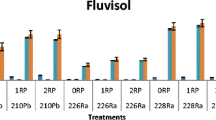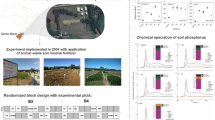Abstract
Phosphogypsum (PG) is a by-product of the phosphate fertilizer industry. In Brazil, three main phosphate industries are responsible for the production of 5.5 × 106 metric tons of PG per year, which is stored in stacks. Part of this by-product can be reused to improve fertility of agricultural soils. For its safe application, it is necessary to characterize the impurities (metals and radionuclides) present in PG and to evaluate their availability to the environment. The main objectives of this paper are: to determine the total concentration of radionuclides (226Ra, 228Ra and 210Pb) and metals (As, Cd, Cr, Co, Cu, Hg, Ni, Pb, Se, Zn) in the Brazilian PG samples using different methodologies, to evaluate the available fraction of these elements in the PG samples using a methodology with mild leaching with EDTA, to compare the results obtained for PG samples with those obtained for the most used phosphate fertilizers. The total concentration obtained for the metals using methodologies with different initial digestion (strong attack with acids and HF and mild attack with nitric acid) are slightly different. The results obtained using the methodology with mild leaching showed that the metals and radionuclides are not available to the environment, giving evidence that the application of PG in agriculture is safe as far as contamination by such elements. PG presented metals concentration lower than the phosphate fertilizers. The results obtained for the PG samples, for As, Cd, Cr, Hg, Ni, Pb and Se, are below the limits established by the Brazilian Regulatory Agency.

Similar content being viewed by others
References
Reservas Estratégicas de Recursos Minerais Para a Indústria de Fertilizantes no Brasil (2010) Secretaria de Geologia, Mineração e Transformação Mineral, Guarapari. http://www.fertbio2010.com. Accessed 13 Dec 2010
ANDA (2002) Anuário da Associação Nacional para Difusão de Adubos. Consumo aparente de P2O5 no Brasil. ANDA, São Paulo
Mazzilli BP, Saueia CHR, Jacomino VMF, Mello JWV (2011) Natural radionuclides and metals intake into soya, corn and lettuce grown on soil amended with phosphogypsum. Int J Environ Anal Chem. doi:10.1080/03067319.2010.549339
CNEN (2005) Diretrizes básicas de proteção radiológica. Norma NN—3.01/001. Comissão Nacional de Energia Nuclear, Brasília
CNEN (2005) Requisitos de Segurança e Proteção Radiológicas para Instalações Minero-Industriais. Norma NN—4.01/001. Comissão Nacional de Energia Nuclear, Brasília
Santos AJG, Silva PSC, Mazzilli BP, Fávaro DIT (2006) Radiat Prot Dosim 121:179–185
Papastefanou C, Stoulos S, Ioannidou A, Manolopoulou M (2006) J Environ Radioact 89:188–198
Garrido F, Illera V, Campbell CG, García-González MT (2006) Eur J Soil Sci 57:95–105
Degirmenci N, Okucu A, Turabi A (2007) Build Environ 42:3393–3398
Papanicolaou F, Antoniou S, Pashalidis I (2009) J Environ Radioact 100:854–857
European Commission (2001) Certification of the contents (mass fraction) of Cd, Cr, Cu, Ni, Pb and Zn in an organic-rich soil following harmonized EDTA and acetic acid extraction procedures BCR 700. Inform Ref Mater. https://irmm.jrc.ec.europa.eu/refmat_pdf/BCR-700_report.pdf. Accessed 17 March 2010
Ministério da Agricultura, Pecuária e Abastecimento MAPA (2006) Instrução Normativa SDA no 27, 05 de junho de 2006. Publicada no D.O.U do dia 09/06/2006, no. 110,seção 1: 15–16
Companhia Ambiental do Estado de São Paulo CETESB (2001) Relatório de estabelecimento de Valores Orientadores para Solos e Águas Subterrâneas no Estado de São Paulo. D. C. P. Casarini and C. L Dias, São Paulo
Le Bourlegat FM (2010) Disponibilidade de metais em amostras de fosfogesso e fertilizantes fosfatados utilizados na agricultura. MSc thesis, IPEN/CNEN, São Paulo University, São Paulo
USEPA (2009) United State environmental protection agency; USEPA 3052, method 3052. Microwave assisted acid digestion of siliceous and organically based matrices. http://www.epa.gov/waste/hazard/testmethods/sw846/pdfs/3052.pdf. Accessed 2 Jun 2009
USEPA (2009) United State environmental protection agency; USEPA 3050B, method 3050B. Acid digestion of sediments, sludges and soils. http://www.epa.gov/waste/hazard/testmethods/sw846/pdfs/3050b.pdf. Accessed 5 Jun 2009
Cutshall N, Larsen IL, Olsen CR (1983) Nucl Instrum Methods 206:309–312
Santos AJG, Mazzilli BP, Fávaro DIT, Silva PSC (2006) J Environ Radioact 87:52–61
Author information
Authors and Affiliations
Corresponding author
Rights and permissions
About this article
Cite this article
Saueia, C.H.R., Le Bourlegat, F.M., Mazzilli, B.P. et al. Availability of metals and radionuclides present in phosphogypsum and phosphate fertilizers used in Brazil. J Radioanal Nucl Chem 297, 189–195 (2013). https://doi.org/10.1007/s10967-012-2361-2
Received:
Published:
Issue Date:
DOI: https://doi.org/10.1007/s10967-012-2361-2




